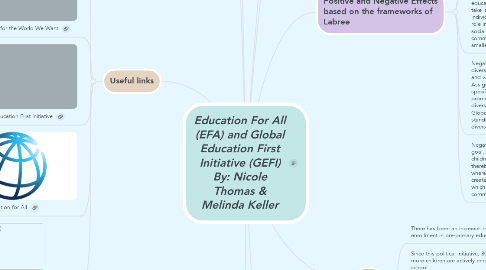Education For All (EFA) and Global Education First Initiative (GEFI) By: Nicole Thomas & Melinda Keller
by Melinda Keller

1. Development
1.1. (EFA) Established in 2000
1.2. (GEFI) established 2012
1.3. (EFA) Revisited 2015
1.4. (EFA) Extended until 2030
2. About
2.1. (GEFI)This initiative worked to “rally together a broad spectrum of actors.”
2.2. (GEFI) Brought education initiatives to the forefront of various agendas, and generate funding through “advocacy efforts.”
2.3. (GEFI) In addition to promoting access to education for all children, this initiative also promoted the importance of quality education and global citizenship.
2.4. (EFA) Countries came together with the same vison regarding education.
2.5. (EFA and GEFI) Main component is Inclusion for all.
3. Useful links
3.1. About | United Nations Educational, Scientific and Cultural Organization
3.2. Quality Education for the World We Want
3.3. NEW Global Education First Initiative
3.4. Education for All
3.5. UNESCO in brief - Mission and Mandate
4. Target Goals for EFA and GEFI
4.1. (GEFI) In 2012, with the prospect of the world falling short of the Education for All goal, the United Nations Secretary-General began the Global Education First Initiative to accelerate the progress towards that promise and refine it's goals.
4.2. Goal #1: Put Every Child in School, including post-primary education. (EFA and GEFI)
4.3. Goal #2: Improve the Quality of Learning, so all students gain basic literacy and numeracy skills. (EFA and GEFI)
4.4. Goal #3: Foster Global Citizenship, so we can work together to find global solutions. (EFA and GEFI)
4.5. Goal #4: Increase adult literacy by 50 percent, especially women. (EFA)
4.6. Goal #5: Achieve gender parity by 2005, gender equality by 2015 ensuring girls have full access to achieve a quality education. (EFA)
4.7. Goal #6: Improve the quality of education. (EFA)
5. (GEFI) Established in 2012
5.1. (GEFI) In 2012, with the prospect of the world falling short of the Education for All goal, the United Nations Secretary-General began the Global Education First Initiative to accelerate the progress towards that promise and refine it's goals.
6. Problem or Solution
6.1. This policy is considered a solution to the problem of Education not being available to all children globally. If we focus on providing access to quality education, as well as lessons in global citizenship to all children, then many of the world’s problems can be solved. This includes poverty, framed as a solution to many of the world’s problems, including poverty (by promoting economic opportunity), gender equality, health, and environmental sustainability. In general, global education is seen as a gateway to a better future to “The World We Want.”
7. Positive and Negative Effects based on the frameworks of Labree
7.1. Positive: In democratic equality, education is preparing children for participation in a democracy. This goal aligns with the Global Education First Initiative’s goal of Global Citizenship. Education to prepare students for their role within the global community.
7.2. Positive: To educate children not just on how to read, write, and count, but also on how to participate in the global, interconnected world – to understand that we are all connected and can all make a difference.
7.3. Positive: Larabee's Social equality goal is considered pertinent to educate children to fill the current needs of the global society.
7.4. Negative: In order to fulfill the social equality goal of education, children need to be a part of a society that requires an educated workforce. This policy does not take into consideration their smaller, individual communities - only children's role in the larger global community. The social equality goal of the global community may undermine that of the smaller, local communities.
7.5. Negative: In order to respect cultural diversity, we need to understand the needs and values of each individual culture. Assigning a global value to education (and specifically a quality education which promotes literacy, etc.) may undermine this diversity. Both the Education for All and Global Education First Initiatives seek to standardize education, thereby reducing diversity.
7.6. Negative: Based on the social mobility goal, this initiative seeks to raise all children up to a basic level of education, thereby creating a meritocracy in societies where it does not currently exist. This may create unnecessary conflict in societies which depend on cooperation and community for their continued success.
8. Pros
8.1. There has been an increase in global enrollment in pre-primary education.
8.2. Since this political initiative, 80 million more children are actively enrolled in school.
8.3. Countries have improved and increased their priorities when it comes to education.
8.4. Recommending education for all is an anchor in moving things forward and allowing there to be benefits in fusing education.
9. Cons
9.1. Poorer children will more than likely not finish primary school.
9.2. 1/3 of the countries have achieved the 6 measurable goals, leaving 2/3 still not able to attain goals they set out to achieve 15 years ago.
9.3. There is a huge financial gap that has become a barrier to providing this education for all.
9.4. Inequality is a major barrier.
9.5. Everything for education is missing. There are no text books, blackboards, desks, electricity, sanitation is an issue, and there is no running water.
9.6. Not enough qualified teachers and buildings.


